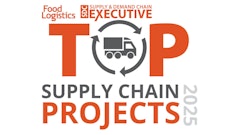
SITE SELECTION
Selecting a piece of land on which to build a food distribution or processing facility is not as easy as one might imagine. It requires a lot more than just going out and finding an appealing chunk of land. Just ask Brian King, majority partner at AM King Construction Co. in Charlotte, NC, who has been assisting numerous food companies in site selection and design/build services over the last few decades.
Where to locate is extremely important relative to proximity to transportation hubs and to an available workforce. And in today’s economy, with many empty commercial and industrial buildings on the market, the decision might rest on the choice of buying and retrofitting an existing building, or purchasing a parcel of land on which to construct a new building. An experienced organization like AM King can guide companies through the process so the decisions are the right ones for companies’ specific requirements.
Take A Holistic Approach
“We consider a project from a holistic perspective,” says King, whose company offers design/build services to numerous industries including the food industry. “We look beyond the elements most owners tend to consider. They know their own businesses very well, but they often overlook the fundamental elements that can’t be seen visually. This is where bringing in a design/build firm like ours can offer a wealth of knowledge these businesses don’t typically get when they deal exclusively with the real estate community.”
The viability and cost-effectiveness of selecting the right site begins with a careful constructability analysis that could include sub-surface exploration to determine soil quality, which helps project potential costs involved in site improvements, explains King. “It’s easy to identify four potential sites and it might be alluring to favor one location simply because it is half the price of the other three locations. Where we bring value to the table is our expertise in examining all of the costs involved in the process of developing a piece of ground; and many times some costs are hidden. For instance, you have to know how far away the utilities are. We can determine if we can bring in utilities more cost-effectively than having to go through major public improvements, which are costly and take a lot of time to accomplish.”
Clearly, the cheapest piece of land could actually be the most expensive once it is developed to a client’s requirements. “A client might want a particular location because of the setting, or because it’s the best spot from a logistics and transportation perspective,” notes King. “It could also be that they feel comfortable with that particular community. All of these factors have to be considered in helping them move forward with their decision. Our job is to help eliminate the guesswork involved in the viability of their decision.”
The company recently completed construction of a food processing facility near Charlotte, NC. That company had outgrown an existing facility, where it employed about 100 people. The owners were uncertain whether to build or buy, so they sought out AM King’s expertise. “This was right around the time that the economy went south and there was a flood of commercial buildings on the market,” reports King. He and his colleagues conducted an analysis of both scenarios, and ultimately decided that it would be more cost-effective for their client to find the right building to retrofit to their requirements rather than finding and buying a piece of land to build on. “We assisted them in this process by reviewing potential properties and evaluating them from a feasibility perspective.”
In this particular case, the processing company wanted to retain their current well-trained workforce, in which was invested a significant amount of time and money in training. This meant King needed to find a location within a reasonable radius of the existing facility. “We often run into situations like this where the big concern is about maintaining an existing workforce,” he says.
Owners typically know the kind of workforce they want, such as a highly educated workforce or a labor-intensive workforce, adds King. So another consideration for many of AM King’s clients is proximity to a community college or technical college so clients can develop relationships with nearby colleges, utilizing the synergy of an available educated and trained workforce nearby.
Honest To Goodness Savings
King has a 15-year relationship with Batavia, IL-headquartered Aldi, Inc. Over that time, he and his colleagues have aided the food retailer in the site selection and construction of about 12 new regional DCs primarily for perishable and dry goods. Aldi’s business model requires situating a DC within a 50-mile radius of a major city, from which it can serve 70 to 100 Aldi retail stores. The food retailer has a very aggressive growth plan, constructing about 80 new stores annually. AM King is involved exclusively in establishing DCs for the retailer – not any of the retail stores. Today, the retailer operates 1,000 stores in 31 states from the East Coast as far west as Kansas. The goal is to establish a presence nationwide.
The newest 500,000 square-foot Aldi DC is located on a 100-acre site in South Windsor, CT, about 50 miles north of Hartford. About 20,000 square feet of that facility houses offices in a Class A office building attached to the DC. “Prior to this project, our company had been involved in conducting site analysis and due diligence required to prepare for construction,” explains King. “This time, Aldi wanted us to help them identify an appropriate site as well as perform the usual services for them.”
Although Aldi has a network of real estate directors in place to handle site selection for its retail stores, it did not have a team handling its regional distribution center site selection, notes Brian McGee, national warehouse coordinator for Aldi, Inc. “The reason for this is because we are a lean operation and everything we do is built around efficiency and productivity,” McGee says.
Probably the biggest challenge in site identification in the Hartford region has to do with the population density, McGee says. “There are limited numbers of parcels of land of the size we needed and at a cost-effective price. This is a big factor for us because, as discount grocers, we are very cautious about how we spend our money. Our goal is to sell the highest-quality products at the best price and that goal cannot be undermined by real estate market conditions.”
King and his colleagues began this project by meeting with Connecticut’s department of economic development. Throughout the project, the team worked closely with the town manager, town council, and the planning and zoning boards. “We negotiated tax incentives and the purchase price of the land on Aldi’s behalf,” he reports. “We handled all of the local approvals. The small town wanted to be certain that Aldi would be respectful of the rural area and develop the building in accordance with the site’s bucolic characteristics.”
Aldi is very particular in its desire to design and build very attractive buildings that tend to be located in pastoral settings. “They were not interested in locating in a large business park surrounded by a bunch of other industries,” explains King. This often means these sites, often farmlands, are challenged by limited access to critical infrastructures. “We often need to have utilities brought in to the site, sometimes constructing anywhere from 500 feet to a half mile to tap into a city-owned water line, for example. It’s an added cost to the owner or developer to bring in public utilities like sewage, water, and electricity. We found that it is more cost-efficient and time-efficient for us to do that work ourselves and then deed the utilities back to the public entity. This allows us to have the utilities we need in a timely fashion.”
Trucks deliver products to Aldi’s DCs, so another requirement is proximity to major interstates. Another is having a large tract of land for tractor trailer storage and being in a location where trucks can come and go throughout the day and night without violating any noise ordinances.
McGee notes that Aldi’s goal is to build partnerships with the teams it works with. “In this case, it was a bit out of the box for us to approach a design builder and ask them to help us identify a site. But Brian King understands our company’s needs very well in terms of the property characteristics we like and our specific construction requirements.”
So AM King assisted the retailer in identifying the perfect location that fit Aldi’s budget, yet met the ongoing cost parameters relative to transportation costs and hiring a successful workforce. “They also helped us locate a site that was the most efficient in terms of servicing our projected store network for this region,” explains McGee.



















